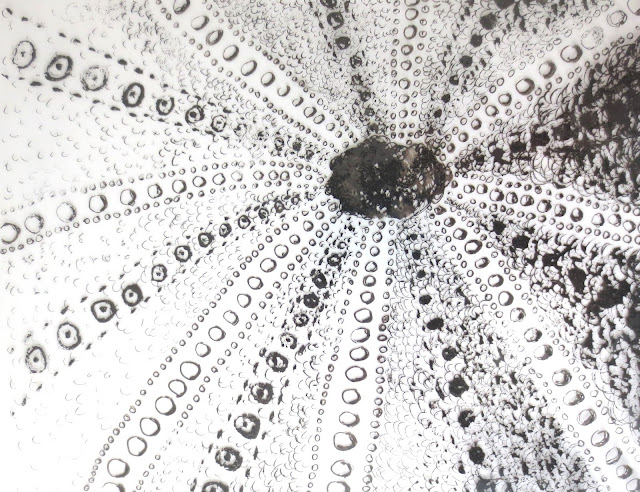 |
| Urchin - A/P1 solar etching 21x15cm ©2016Lisa Le Quelenec |
Having signed up for a second term of printmaking at the Arts University Bournemouth last year I was very excited to learn that we would have the opportunity to try our hand at solar etching. This technique appeals to me as there is no acid involved and so is something safer for me to do at home whilst I have an inquisitive toddler roaming around.
Solar etching uses a light sensitive polymer coated plate to transfer an image from a clear film. The image could be a photograph or drawing photocopied onto acetate or something made directly onto a transparent sheet. I chose to work directly and so onto a piece of plastic I drew with alcohol based drawing pens making a variety of marks and building up the density to get a good variation of tone.
 |
| Urchin drawing on acetate ©2016Lisa Le Quelenec |
Once this was complete the plate was first prepared using an 'aquatint' sheet ( a sheet of film that has a very, very fine and even tone, digitally print and so dotted surface). Laying the plate onto this sheet and exposing it in a lightbox meant that I would get a more subtle variation in tones from my plate when I processed my drawing. Next the drawing is placed on the lightbox with the plate on top and exposed. Moving quickly so as not to over expose the plate to too much extra light it was placed in a bath of warm water to wash off the light sensitive coating using a soft brush. (You know that the coating is fully removed when the plate no longer feels slimy to touch.) The final stage in plate preparation is to give the plate a further exposure in the lightbox to 'harden' off. Once this has been done the plate is ready to be inked up and run through the press in the same way a traditional etching plate. The plates are very strong and a fairly large edition can be achieved without loss of image quality.
(The timings of exposure vary from lightbox to lightbox but this process can also be done using direct sunlight but as the strength of light isn't as controlled the results can be harder to predict so I am told.) Roll on summer as I am seeing this process featuring again in my future. I would like to experiment with using different materials to do the drawing with for a wider variety of marks maybe chinagraph pencils, ink/paint applied with brushes.... also using photocopies of paintings and drawings perhaps?
 |
| Urchin drawing, plate and print ©2016Lisa Le Quelenec |
For now I am experimenting with inking up the plate and seeing what I can do with it. Different ways of manipulating the ink on the plate are giving exciting results. The centre print was inked up using a roller as if it was a relief block.
 |
| Urchin A/P 2,3&4 solar etching 21x15cm ©2016Lisa Le Quelenec |

5 comments:
These are beautiful! And I like the non-toxic aspect to them.
Beautiful !
Hi Rhonda, thank you so much. The lack or acid makes it a winner to me too. Much more accessible for doing at home.
Hello Ashok, thank you for taking the time to comment and welcome.
fascinating post Lisa ...and really beautiful results ...all the best with your printing course
Hi Jane, thank you. The course was so enjoyable that I might go again later in the year. It was exciting to try new processes and has given me a new perspective in my old working methods too...really invigorating.
Post a Comment